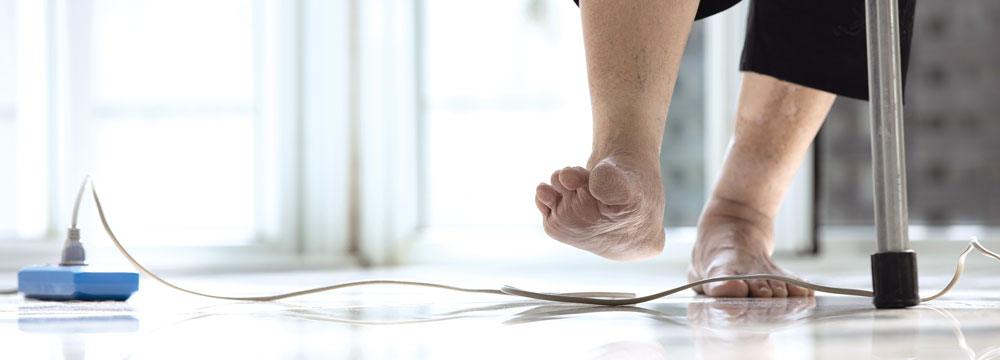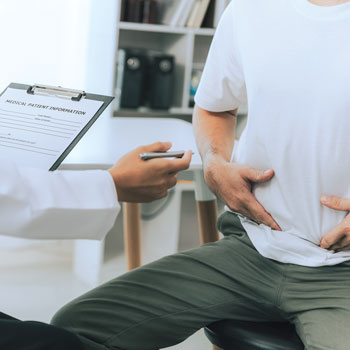
Age and the rising risk of falling
More than 14 million U.S. adults, one in four of those ages 65 years and older, report falling each year, according to federal data.
Fall prevention in older adults constitutes a chronic challenge that internal medicine physicians can't address in a single office visit. Instead, a multifaceted approach over time must be used to reduce the risk of falls and fall-related injuries.
More than 14 million U.S. adults, one in four of those ages 65 years and older, report falling each year, according to federal data. More than one-third, 37%, require medical attention or opt to temporarily restrict their activities as a result. Meanwhile, the fall-related death rate has increased 41% from 2012 to 2021.
Older individuals with multiple conditions now live longer, including independently, which is good news, said Elizabeth Eckstrom, MD, MPH, MACP, a professor and chief of geriatrics at Oregon Health & Science University in Portland. But they may become increasingly frail and isolated with the passing years, she said. “Fewer people [are] around to help them out if they fall, so therefore they may not be getting medical attention as soon as they could.”
Even a minor fall can have a cascading impact, leading some older adults to curtail their activities in a misplaced effort to avoid another fall, said Thomas Gill, MD, a geriatrician and professor of medicine, epidemiology, and investigative medicine at Yale University in New Haven, Conn. “But that increases the likelihood,” he said. “Because they become less physically active, they lose muscle strength, their gait and balance may worsen, and so then they become more susceptible to a subsequent fall.”
Internal medicine physicians can recommend a battery of preventive measures, according to geriatricians and other experts. Along with encouraging older adults to incorporate strength and balance-training activities into their exercise routines, physicians can review a patient's prescriptions for high-risk medications. Substances such as alcohol can also pose a notable risk. A 2023 Annals of Emergency Medicine analysis found that alcohol-associated falls had increased by 7.5% annually from 2011 to 2019 among adults ages 65 years and older, along with a similar increase among adults ages 55 to 64 years.
In addition, physicians can encourage patients and their caregivers to scrutinize their homes for throw rugs and other potential hazards using a checklist, such as the one developed by the CDC's STEADI (Stopping Elderly Accidents, Deaths & Injuries) initiative.
The STEADI initiative provides a range of resources, including videos and screening checklists, for patients and physicians. The National Council on Aging also features various tools, including a home safety checklist and a 13-question screening tool to assess individual fall risk.
As with other chronic issues, such as diabetes control, physicians need to keep revisiting the subject, said ACP Member Elizabeth Phelan, MD, MS, a professor of medicine and geriatric medicine at the University of Washington and medical director of the fall prevention clinic at Harborview Medical Center in Seattle.
“You have to keep bringing it up and chipping away at it,” she said. “It's not something that you can do in a single visit—it's not a one-and-done, in other words.”
Routine screening
Research indicates that some older adults perceive falls as inevitable and don't realize that they can better protect themselves, said Katelin Alfaro Hudak, PhD, a coauthor on a systematic review of fall-related studies published in Age and Ageing in 2023.
Physicians can boost awareness “providing information about falls, including about the prevalence of falls,” said Dr. Alfaro Hudak, an assistant professor at Texas A&M AgriLife Research Center at El Paso, “telling patients that falling can and does happen to people who are relatively young and healthy.”
A good starting point is routinely asking older patients if they've recently experienced a fall. Fewer than half of older adults will notify their clinician if they do, according to federal officials.
STEADI provides a shortened three-question version of its 12-question screening tool that clinicians can easily administer in the office. Along with finding out whether patients have had any falls during the prior year, the tool also screens for whether patients worry about falling or whether they feel unsteady when they walk or stand.
During an office visit, physicians can quickly gain a sense of a patient's mobility, Dr. Gill said. His approach is to ask patients to stand up from an office chair with their arms crossed to see if they can accomplish that movement in a single attempt, one indicator of quadricep strength, he said. He then asks them to walk down the office corridor and back, providing an opportunity to assess their gait and balance.
“The whole process takes a minute, and you get so much information from that,” he said. “It can be very reassuring as well.”
Given the time constraints on office visits, internal medicine physicians may prefer to focus this assessment on patients ages 75 years and older or those who may appear more vulnerable due to a reliance on a cane or a walker, or for another reason, Dr. Gill said. That corridor walk, he added, also provides physicians with the opportunity to point out any risky footwear choices, such as high heels or shoes like clogs that don't cover the heel.
Addressing meds
Adults who have fall-related injuries are highly likely to already be taking one or more drugs that place them at greater fall risk, with the prevalence ranging from 65% to 93%, according to a systematic review published in the June 2020 Journal of the American Geriatrics Society. Antidepressants and sedatives-hypnotics were the two classes most frequently prescribed.
Dr. Phelan, a coauthor on the systematic review, has since published a randomized study looking at whether a primary care deprescribing intervention reduced the use of five classes of central nervous system-active medications (opioids, sedative-hypnotics, skeletal muscle relaxants, tricyclic antidepressants, and first-generation antihistamines). Researchers also tracked the first fall among the participants—2,367 adults ages 60 years and older—that required medical attention.
The serious fall rate in the intervention group, which paired patient education with clinical decision support, didn't significantly differ from the control group, according to the findings, published July 25, 2024, in JAMA Network Open.
The lack of fall-related reductions may be explained in part by the health system's addition of system-wide deprescribing measures during the study, such as an electronic health record alert that flagged coprescribing of opioids and benzodiazepines, Dr. Phelan said. “It did make it harder for us to show an effect of the intervention.”
Even so, primary care physicians should continue to deprescribe high-risk medications, when feasible, to help patients avert falls, Dr. Phelan said. “I would say definitely yes,” she said. There are additional reasons for deprescribing these drugs, she noted, including the fact that they increase risk for cognitive impairment/dementia and cause orthostatic hypotension, another contributor to falls.
Clinicians have been more likely in recent years to prescribe high-risk medications despite their fall-related potential, Dr. Eckstrom said. She cited a study, published in 2021 in Pharmacoepidemiology & Drug Safety, finding that 94% of adults ages 65 years and older were taking at least one high-risk medication in 2017 compared with 57% in 1999.
The time pressures on primary care physicians may have influenced this trend, Dr. Eckstrom said. For instance, it's not a quick conversation to walk a patient through the risk of sleep medicines as well as various nonpharmacological options.
“They've only got a 15-minute appointment,” she said. “They're in a hurry, they have several other conditions to manage, and they just give the patient a sleeping pill. And that's absolutely the wrong thing to do.”
Other interventions
Even when physicians are short on time, they can pursue several key prevention measures in just a few minutes, such as reviewing the patient's list of prescriptions to see if there are any “really egregious offenders,” Dr. Eckstrom said. They can educate patients about any risky over-the-counter medications, such as those that combine acetaminophen and diphenhydramine. Also critical, she said, is making a referral to physical therapy and talking up the benefits of tai chi to any at-risk adults.
Dr. Eckstrom coauthored a study in which 670 adults ages 70 years and older with a history of falls or impaired mobility were randomly assigned to twice-weekly tai chi classes; a multimodal exercise program that included aerobic, strength, and balance activities; or a control group that did stretching exercises. After six months, the tai chi group had 58% fewer falls than the control group and 31% fewer falls than the multimodal exercise group. The findings were published in 2018 by JAMA Internal Medicine.
Other interventions include vision screening to catch any emerging difficulties, according to the CDC's STEADI prevention guidance. Older adults who wear bifocal or progressive lenses, even if the prescription is correct, can be vulnerable to falling when walking outside as they will be looking through the reading portion of the lens when they look down and may not see an uneven sidewalk or curb, Dr. Eckstrom said. Ideally, they should purchase a pair of glasses with a single-distance lens to navigate curbs and other outdoor obstacles, she said.
Other potential prevention measures, such as vitamin D supplementation, have not panned out in recent studies, said Lawrence J. Appel, MD, MPH, FACP, a professor of medicine at Johns Hopkins School of Medicine in Baltimore. He led a randomized trial, published in 2021 in Annals of Internal Medicine, finding that a high vitamin D dose of 1,000 IU per day didn't prevent falls any better than a low dose of 200 IU per day in adults ages 70 years and older. Rather, the rate of a serious fall or fall with hospitalization was higher among adults on the higher dose. “We really didn't see any signal of benefit—if anything there was a signal of harm,” he said.
Dr. Eckstrom said that she typically only looks at an older adult's vitamin D levels if they have osteopenia or osteoporosis, which boosts their likelihood of a fall-related fracture. Before prescribing bisphosphonates or denosumab, she checks their vitamin D level to ensure that it is sufficiently high for the drug to be effective.
Physicians can perhaps exert the greatest fall prevention impact by involving caregivers and loved ones when discussing potential hazards that lurk in the home and providing related educational materials, Dr. Appel said. Plus, they can alert older patients that the overnight hours can be particularly risky; for example, making a bathroom trip can lead to a fall, particularly in those prone to orthostatic hypotension, he said.
“The idea is to always be cautious but especially at night getting up from a seated position, whether it's getting up from bed or getting up from the toilet,” he said. “Take your time. Gather your strength.” Dr. Phelan added that older patients should consider using a flashlight and ensure that their path to the restroom from the bed is free of obstacles and trip hazards.
A multifaceted approach
One large-scale primary care intervention, which enrolled 5,451 adults ages 70 years and older across 86 primary care practices, looked at whether pulling together various components of fall prevention proved to be effective in a real-world setting. The study, called STRIDE (Strategies to Reduce Injuries and Develop Confidence in Elders), involved fall prevention nurses and included risk assessment and individualized plans.
Researchers identified an 8% reduction in serious fall injuries and a 10% reduction in all self-reported fall injuries in patients assigned to the intervention versus usual care, according to the findings, published in 2020 in the New England Journal of Medicine. The decline in serious injuries didn't reach statistical significance, although the decline involving all fall injuries did.
One potential factor was that the criteria to identify an injury as serious were stringent and included verification through the medical record, said Dr. Gill, one of the principal investigators. But fewer injuries, including those that aren't serious, can have a meaningful impact, he said.
“There's strong evidence based on prior work that fall injuries are associated with decrements in how one can function on a day-to-day basis,” he said. “That's often the outcome that's of greatest interest to older persons. They want to maintain their independence.”
The researchers had initially hypothesized that the intervention would cut serious falls by 20%. The more limited preventive benefit illustrates the challenges of implementing a complex intervention that relies on behavioral change, Dr. Gill said. Among the hurdles that researchers pointed out was that exercise and other behavioral changes were not routinely monitored. Plus, patients could select which strategies to pursue, and some high-value options weren't as popular, such as cutting back on high-risk medications.
Dr. Eckstrom, who was not involved with STRIDE, said the findings highlight the importance of consistent attention. “They did this intervention, but there wasn't very much follow-up,” she said. “So nobody came back and asked again, ‘Hey, did you actually get to that tai chi class?’”
To that end, physicians should tackle fall prevention with more of a team-based approach, incorporating nurses and pharmacists when feasible, and taking the longer view, she said.
“We need everybody paying ongoing attention to these patients. We need to engage the caregivers,” Dr. Eckstrom said. Fall prevention, she said, “works best if we are continually attentive to it.”



